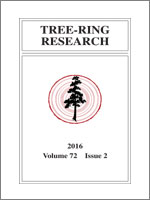Minimum blue-intensity (BI) appears to be a viable source of proxy-temperature data, but is yet to be applied to a Southern-Hemisphere species. Here, we apply the BI technique to Podocarpus lawrencei, a conifer endemic to the Australian Alps. We develop sample-preparation protocols and examine the climate sensitivity of resulting tree-ring width (TRW) and BI chronologies. We found that extractable resins were removed from P. lawrencei samples after 28 hours of Soxhlet extraction and a highly-significant negative correlation (r = -0.79, p<0.0001) exists between the resulting BI chronology and growing season (August–April) temperature maxima. The climate sensitivity of our BI data, combined with an apparent teleconnection with a previously-reported dataset, suggests that an unparalleled opportunity exists to develop a powerful proxy for growing-season temperatures in southeast Australia.
How to translate text using browser tools
1 July 2016
Application of the Minimum Blue-Intensity Technique To A Southern-Hemisphere Conifer
Matthew Brookhouse,
Rochelle Graham
ACCESS THE FULL ARTICLE

Tree-Ring Research
Vol. 72 • No. 2
July 2016
Vol. 72 • No. 2
July 2016
Australian Alps
dendroclimatology
growing season
maximum temperature
Podocarpus lawrencei
teleconnection




